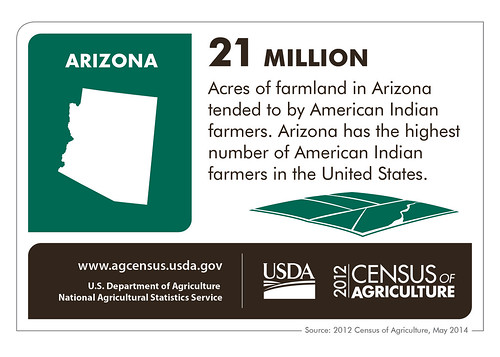
The Census of Agriculture is the most complete account of U.S. farms and ranches and the people who operate them. Every Thursday USDA’s National Agricultural Statistics Service will highlight new Census data and the power of the information to shape the future of American agriculture.
For decades, school children in Arizona have been taught the five Cs: Copper, Cattle, Cotton, Citrus, and Climate. These five C’s have been the driving force behind Arizona’s economy, and gave economic security to past generations and hope to many generations. However, all that is changing. Arizona, like the rest of the country, is undergoing an economic transformation. Arizona is moving from a mining and agriculturally oriented economy, to a high-technology and service-based economy. This is changing the patterns of where Arizonans live and work.
Three of Arizona’s Cs – cattle, cotton, and citrus – were counted in the most recent Census of Agriculture and the results showed that they are still economically significant. The value of cattle, cotton and citrus production that was sold in 2012 totaled nearly $940 million, excluding the more than $760 million in milk sales. Total market value of all agricultural products sold topped $3.7 billion.
The Ag Census also stayed true to USDA’s focus on new farms. These include minority-operated farms, young farmers new to agriculture, small producers of specialty commodities and organic operations. Historically these types of farms have been undercounted or have been very difficult to count. Arizona has an especially strong connection to these farms as we have the highest number of American Indian farmers in the United States. The total number of American Indian farms in Arizona rose to more than 11,000, which means that as of 2012, American Indian operators run more than half of all farms in our state. These farms cover almost 21 million acres of land, which is nearly 80 percent of all farmland in Arizona.
In our state, as well as in the rest of the United States, the average farmer is getting older. The average age of farmers and ranchers in Arizona is 61 years old. The number of young farmers (under 25 years old) rose but still made up less than one percent of all farms.
What else can be said about Arizona agriculture? The agriculture base in the Grand Canyon State is truly unique and ever-changing. However, one thing seems certain to remain the same. Arizona farmers and ranchers will continue to face challenges with water, weather and the economics of farming and ranching and NASS will continue its role in providing quality data to help producers make sound decisions.
